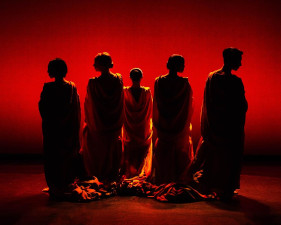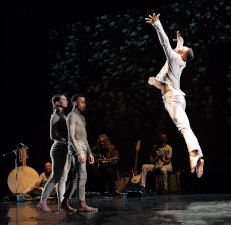
Karen
Bardash
A
Trajectory:
Limón Dance Company: 75th Anniversary Season The Joyce Theater welcomed back the Limón Dance Company for its pandemic-delayed 75th anniversary season, resplendent with choreography that spanned nearly a century. Program A (week 1) was comprised of four dance numbers and Program B consisted of three. The sonorous, inviting voice of the narrator Dion Mucciacito introduced each, supplying the audience with a tidbit of history or insight into its inspiration. The words served as a pleasant and informative segue to what followed.
“Air for the G String” was choreographed in 1928 by Doris Humphrey, one of Limón’s first dance teachers. A timeless piece at nearly a hundred years old the choreography was mesmerizingly stunning, and the dancing was a breath of beauty and fresh air. As almost life-imbued Grecian sculptures, five dancers in flowing gold ropes moved to J.S. Bach’s “Suite No. 3 in D Major, Air.” Their graceful forms harmoniously glided and filled the stage. Every movement, from outstretched fingers down to their feet and beyond, was accentuated by the robes that trailed like ripples in water behind them. If only the lulling gentleness of this number would have lasted past the few short minutes that it did. In complete contrast to the above, “Psalm” (1967) followed. Choreographed by Limón at the period in his life when he was diagnosed with cancer, this piece was infused with darkness. Whereas Mucciacito’s narrations, for the most part, were ambiguous enough not to overly influence the audience what was gleaned through this introduction painted two clear pictures; one, Limón’s sense of mortality and the second, the story from the Talmud of Lamed Vav Tzsdikim, the “36 righteous ones.” You might Google this all on your own, but the short version is: at all times there are 36 special people in the world, and if one dies then the world ends. Those are some big shoes to fill, or even egocentric ones, if “Psalm” portrays a dying Limón as also one amongst 36 such special men. In contrast too, to Bach’s warm and embracing score, the percussive, rapid paced, seemingly unending music by Eugene Lester, was unnerving and the repetitive pieces of Hebrew prayer interjected were unsettling. All this and still there is the dance to discuss. One dancer represented the “just man”, or as the program read, The Burden Bearer. Nicholas Ruscica danced the role at the matinee on the 23rd. He did a fine job through body and expression representing a tormented, pain-infused, lost man/soul. The parts in which the large corps danced were more interesting as they were filled with kinetic energy and unison in which the numerous dancers vertically rose up or fell in jumps. The angularity of sharp elbow or flexed feet were a welcomed overall distraction. However, no matter the talent of the dancers, this was an uncomfortably long and unthought-provoking piece.
“Chaconne” (1942) followed the intermission. This short number featured one dancer; Frances Lorraine Samson accompanied on-stage by violinist Johnny Gandelsman soulfully playing J.S. Bach’s “Chaconne from Partita #2 in D Minor.” Against a stark black background, the spotlights highlighted the two as they complimented one another. The Chaccone is a dance that originated in Spain in the 1600s and in the costume selection there was a nod to Spain in the high waisted black trousers the dancer wore, giving a slight air of male flamenco attire, although the two dance styles are unrelated. Paired with a simple skin-colored top there was nothing to distract from the superb dancing or the beautiful leg extensions accentuated by the dancer’s soft leather shoes. Limón’s choreography blended the posturing of Flamenco dance, fiery movement, and a joyfulness which was evident in the smile that beamed from Ms. Samson’s face as the number progressed.
Program A ended on a high note with “Only One Will Rise,” a world premier by the Burkinabé (from Burkina Faso) choreographer Olivier Tarpaga. On stage three musicians, on guitar, electric guitar/bass and an assortment of drums and indigenous percussion instruments, provided a party-like atmosphere with an uplifting score by Olivier Tarpaga and Tim Motzer. Geometric patterns were projected on the back of the stage moving to the beat of the music as the twelve dancers communicated through the choreography a sense of hope, growth and interconnectedness. The dancing was fluid with bodies undulating organically and sensually or at other times articulated with violent gesticulations. “Only One Will Rise” was a fast, engaging journey through music and dance which perfectly rounded out the afternoon’s varied program. Program B (week 2) presented three other pieces, each vastly different from the others. Limón began choreographing “Waldstein Sonata” in 1971 but never saw it to fruition. The work was completed in 1975 by Daniel Lewis, but until this season now at the Joyce Theatre had never before been danced by the José Limón Dance Company. An homage to Beethoven, this piece beautifully interpreted the composer’s “Piano Sonata no. 21 in C Major, Opus 53.” Pianist Soheil Nasseri exuberantly accompanied the eight dancers. The group numbers were lively and perfectly synchronized, and the partnered segments featured graceful lifts. Decked out in sherbet-colored costumes reminiscent of ices on a hot summer day, “Waldstein Sonata” was delightfully airy and fresh. This contrasted greatly with the two dances that followed. “Danzas Mexicanas” (1939, 2022) was Limón’s first solo choreography. As a partially lost piece, with no full video archival references, it was collaboratively reimagined this year by Dante Puleio and the company dancers. “Danzas Mexicanas” is series of five solos that drew from Limón’s personal cultural heritage in his interpretive portrayal of five historic Mexican figures: Indio, Conquistador, Peón, Caballero, and Revolucionario. Five dancers represented each of these personas. The costumes by Limón assisted in the interpretation as did the projections by Michael Clark. The indio (Robert M. Valdez, Jr.) danced low to the ground, the conquistador (Savannah Spratt) wielded an imaginary sword, the peón’s (Terrene D.M. Diable) bare-chested muscular physique more than portrayed the working man, the caballero, (Johnson Guo) strutted and postured like an aristocrat, and the revolucionario (Laurn Twomley) crouched anxiously. However, none of these parts individually amounted to much, and the piece as a whole was reductive. The afternoon’s performance ended with a world premiere of Mexican choreographer Raúl Tamez’s “Migrant Mother.” Talk about successful story telling! Watching this dance was a totally a visceral experience, uncomfortable yet incredibly engrossing. When the curtain rose, the dancers lay as if dead, limbs twisted, upon the stage scattered with white roses and petals. Slowly and horrifyingly, they started to move, jerk and incredibly propel themselves into the air from a prone position. Two intertwined dancers writhed in a way that wasn’t even humanly recognizable. As the piece progressed and the dancers stood, they shook and twitched. They lifted, dragged, carried one another on a seemingly long and anguished journey. The lighting by Al Crawford bore down on them as would the scorching sun in a desert. The costumes by Edgar Sébastien hung loosely from their frames giving the dancers a dusty, exhausted appearance. The soundtrack, a compilation of many pieces in Spanish and indigenous languages, was uncomfortably harsh but so necessary to complete this masterpiece; and interjected throughout were the groaning and heart-wrenching screams of the dancers. Towards the end, a fleeting few minutes of jubilation; in fantastic leaps the dancers flew through the air. Was this the culmination of a journey, the realization of promise? Finally, gifted dancer MJ Edwards, with a deer head perched upon his own, agilely traversed the stage and the air above with such force and athleticism until finally the animal lay spent or dead on the ground. The symbolism, I am not sure. A finale to Tamez’s triumph of a piece, perfection. For the final curtain call, one by one, the dancers moved forward, kneeled, kissed the floor and prostrated themselves. Were they doing this as themselves, the dancers? Were they doing this for the “Migrant Mother” or all others who have sought to fight for survival, to be heard, to be seen? A gesture of gratitude? An expression of relieve after a long journey? This was an ideal ending for the Limon Dance Company’s homecoming to the Joyce Theater, received with such gratitude from the public who welcomed them back. |
| recordings | coupons | publications | classified |



